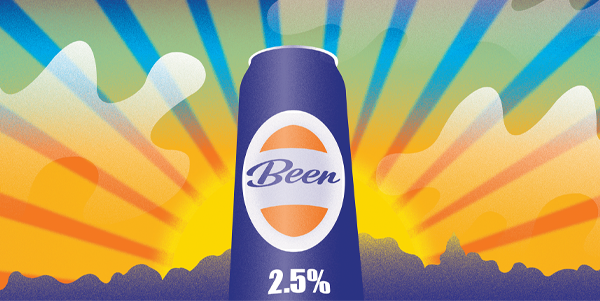A Commentary with Stephen Beaumont
For the past few years, without question the most talked about segment of the beer market in the western world has been low and no alcohol lagers and ales, commonly abbreviated as “lo & no.” However, the overwhelming emphasis has typically been placed upon the “no” part of the equation, referencing the still small but rapidly growing category of alcohol-free beers.
So what about the “lo” portion, then? Turns out, it is also in growth mode, at least in large parts of Europe, partly thanks to a resurgence of interest in traditional beer styles such as the English mild and ordinary bitter and German Berliner weiss, partly owing to the creativity of brewers seeking to fill the gap between zero alcohol and light beer, and partly out of necessity.
On the necessity side, a revised tax structure in the United Kingdom sees beers of 3.5% or greater taxed more heavily than those under that threshold, resulting in breweries seeking lower alcohol strength levels for their brands, a phenomenon the media has dubbed “drinkflation.” Among those beers that have experienced a drop in strength are Asahi-owned Grolsch (4% to 3.4%), Heineken-owned Sol (4.2% to 3.4%), Carlsberg Pilsner (3.8% to 3.4%), and Coors (4% to 3.4%).
Similarly, an Australian tax structure that imposes disproportionately higher levies on beers of significant strength while heavily favoring moderate to appreciably low alcohol beers has given rise to what is known locally as the “mid-strength category,” populated by beers of 3% to 3.5% alcohol. And here the Aussies have proved particularly adept, cramming remarkable amounts of flavor into mostly ales, but occasionally also lagers and mixed fermentation beers, of quite moderate strength.
Back in the United Kingdom, the sharp-eyed will have noticed that all of the beers listed above are international brands of lager, which while undeniably successful in the UK market are not necessarily indicative of the traditional skill set of British brewers. For that, one must look to traditional, warmer fermentation ales, more specifically cask-conditioned ales.
A recent journey through London and the English midlands revealed any number of highly flavorful, lower alcohol cask ales, none of which needed to be lowered in strength to meet the new tax threshold. Sussex-based Harvey’s Brewery’s XX Dark Mild, for instance, is delightfully malt-forward and a mere 3% alcohol, while Nottingham’s Castle Rock Brewery offers a citrusy Our House Extra Pale Ale at 3.4%. And while West Yorkshire’s Timothy Taylor might be best known for its 4.3% Landlord, neither does it disappoint with the 3.4% Golden Best.
Even those ales that have been reduced to fit the new tax regime, such as the Asahi-owned Dark Star Brewery’s Hophead (now 3.4% rather than 3.8%) show little if any change in flavorsome impact.
Then there are innovators like London’s Small Beer Company, specialists in brewing beers under 2.8% alcohol, and Bampton, UK’s Shandy Shack, purveyors of craft shandies in the mid-2% strength range. Both of these companies view low alcohol beer not as a curiosity of the market that might be satisfied by a single brand or two, but rather as a growing sector rife with potential.
With strict drinking and driving laws and a strong cycling culture, Germany has also long been a healthy market for lower alcohol beers, although most often reducing strength through the addition of juices or sodas to make radlers and so-called colabiers rather than specifically fermenting to lighter alcohol contents. Still, lower strength leichtbiers – literally light beers – of varying styles are, if not quite commonplace, at least relatively easy to find, and such traditional low strength beers as Berliner weiss and Lichtenhainer are not only enduring, but may in fact be growing in popularity.
In Belgium and parts of France, the tradition of table beers likewise persists, although in a market that is considerably smaller than it was even twenty or so years ago. Originally intended for enjoyment at mealtime by the whole family, children included, such beers are typically under 2% alcohol and were, in 2001, proposed by a school board in Hasselt as an alternative to sugary sodas for children, an experiment which never made it beyond the exploratory stage. At the most recent reference point, between 20 and 30 table beers were still in regular production in Belgium.
In North America, on the other hand, the “lo” part of “lo and no” is dramatically underserviced, to the point that a recent Food & Wine magazine story headlined “Low-Alcohol Beers Are Trending Like Never Before — Here Are 10 to Try” featured just one brand under 4% alcohol and two of over 5%, which most would view as more the industry norm for the strength of packaged beers.
Even those brands billed as “table beers” at craft breweries in North America tend to resemble more conventional light beers than they do their Belgian stylistic namesakes, often clocking in at closer to 4% alcohol than 2%. Typical examples include Creature Comforts Table Beer at 4.3%, Oxbow Brewing Again & Again at 3.5%, and Dageraad Brewing’s Burnabarian at 4.5%.
Which is not to say that the “lo” segment has been entirely ignored in North America. Among the more successful forays into the market have been Jester King’s Le Petit Prince at 2.9%, Side Project Brewing’s 2.5% alcohol à la Table, and Godspeed Brewing’s 1.5% Baby Světlý. On the whole, however, these beers represent but the very tip of a toe dipped into a vast lake of possible sales.
It’s anybody’s guess why this reluctance to enter this potentially lucrative market endures, but I would suggest that perhaps it has something to do with the way American and Canadian beer drinkers have historically equated strength with price. With attitudes towards alcohol changing and younger drinkers showing interest in moderating their intake, however, it is likely time to afford “lo” at least as much attention as the “no” part of the low and no alcohol segment.



